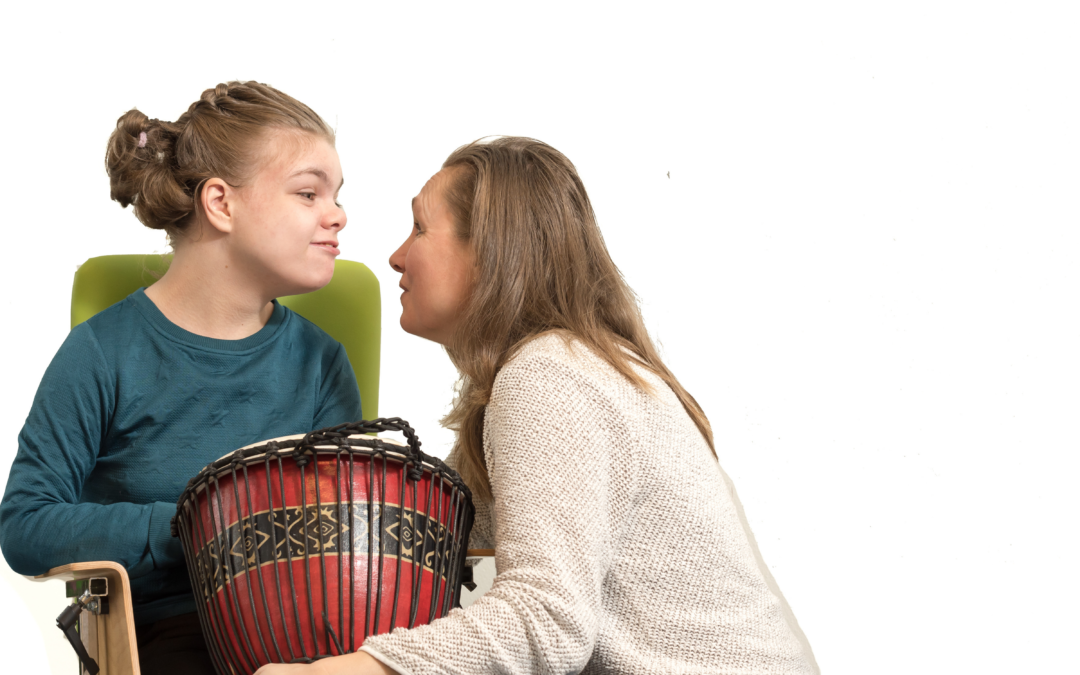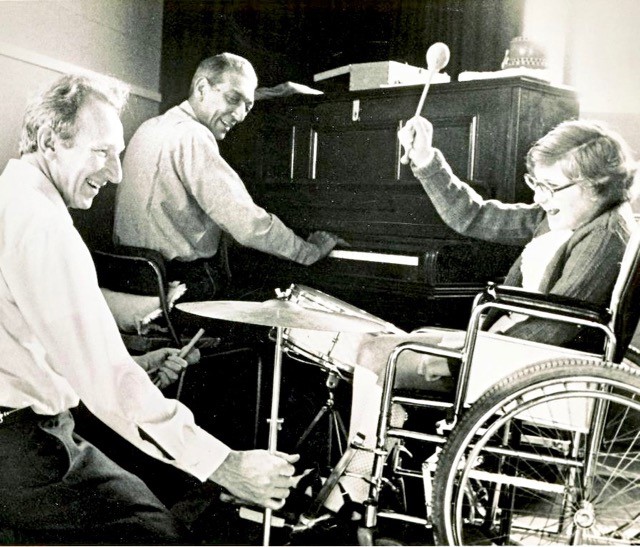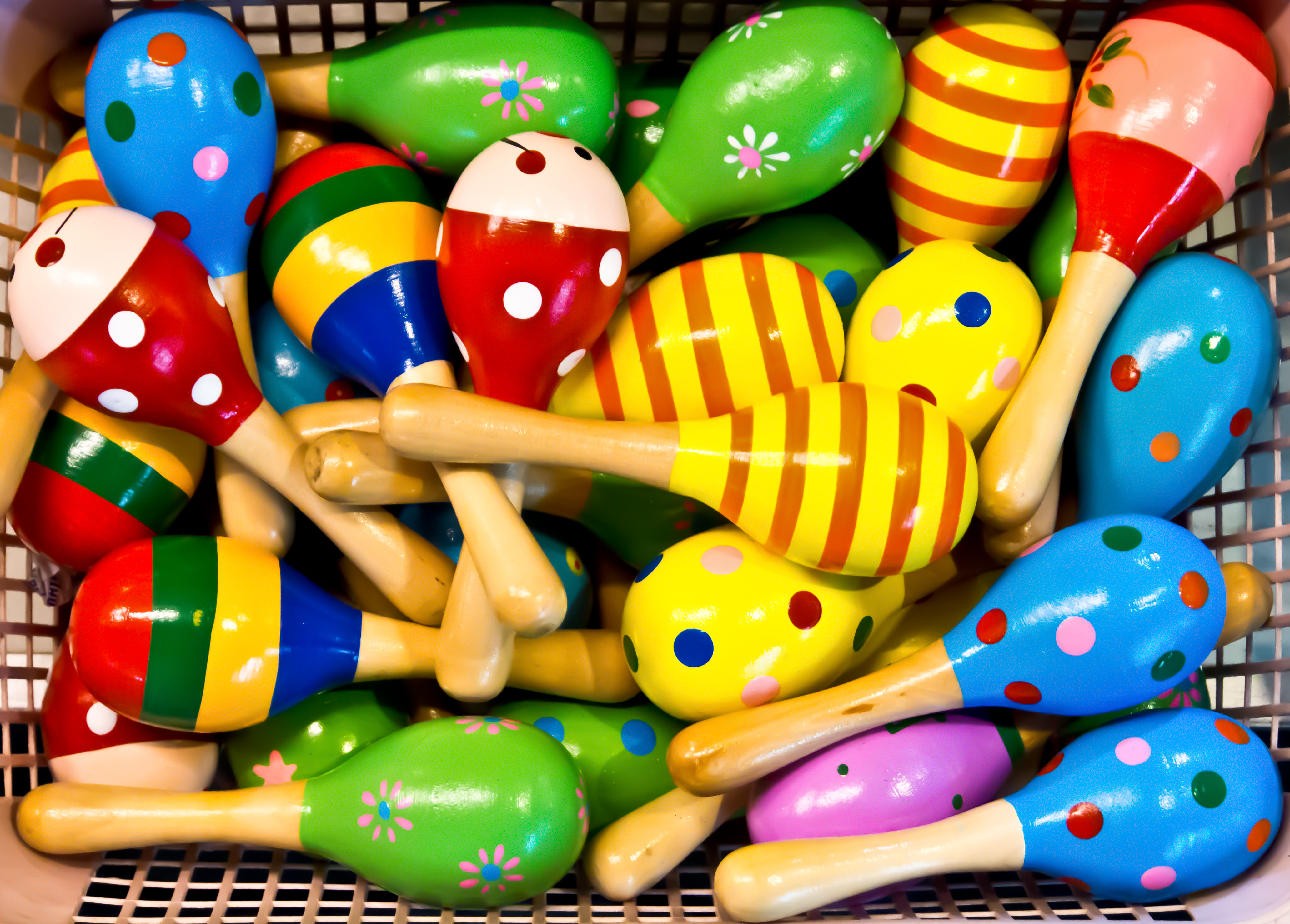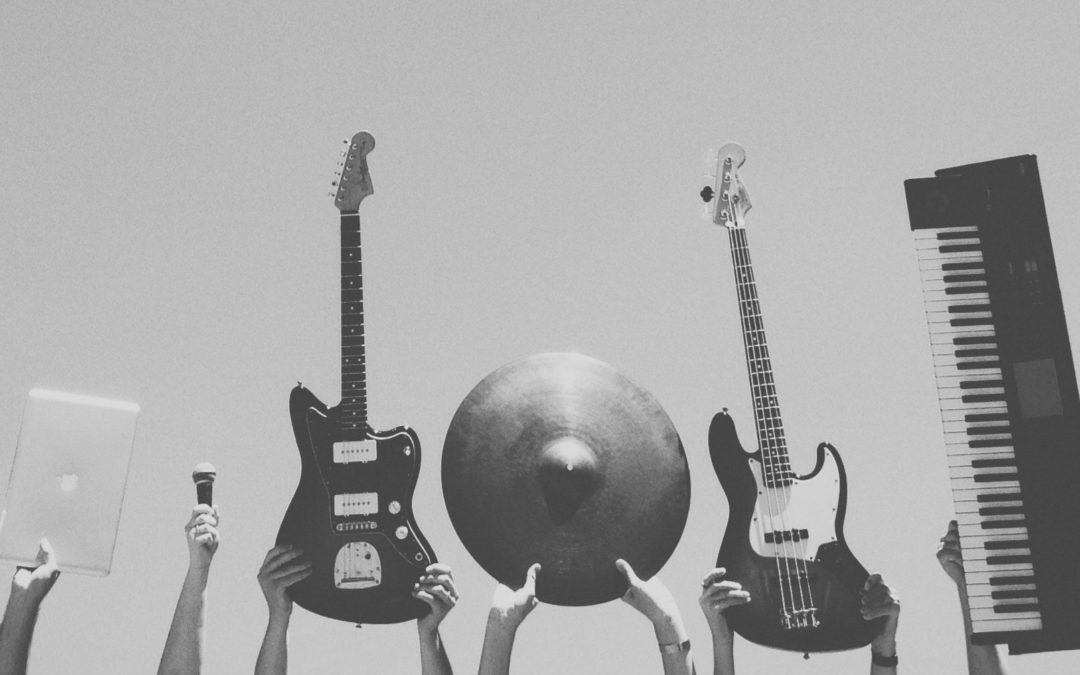
by Erin Triola | Feb 7, 2021
Blog post written by Katie Pistilli.
Music therapy is a creative arts therapy. As creative arts therapists, music therapists work to harness the power of music and creativity to address their client’s non-musical goals. These goals could be related to speaking, movement, or emotional expression, among many others. Upstate Music Therapy Center therapists most often work in school-based settings, and our students often have goals related to achieving success in the classroom. Success happens when the therapist can structure a motivating creative environment where the child can thrive.
Music therapy sessions are individualized. No one session will look alike. Music therapists always try to structure the session to meet the one-of-a-kind needs of a particular student.
While all sessions are unique, in a school-based setting, there are a few things sessions have in common:
1. There is organic music.
Organic music is naturally produced using instruments played by the therapist, live in the moment. The opposite of organic music is inorganic, meaning it is recorded and the therapist is not actively creating it. Music therapists make their own music during the session to best accommodate the needs of the student. By playing instruments such as guitar, piano, percussion, and singing in the moment, the therapist can create a flexible and individualized creative environment. Keep in mind, this does not mean there is no recorded music used at all. There are certainly scenarios where a therapist may utilize inorganic music as well.
2. There is often a greeting song and a “goodbye” song.
While this is certainly not a universal rule, many music therapists choose to start their session with a greeting or check-in song. For many students, routine and repetition is comforting. New music can sometimes be confusing, and by starting the session with a familiar activity or song may elicit a sense of peace amidst an otherwise hectic day. The greeting song also offers an opportunity to address and talk about emotions or events of the day.
Similarly, as a child completes their music therapy session and prepares to transition back to the classroom, the therapist uses another familiar song. For children, this song prompts a “goodbye” conversation. Leaving a peaceful and fun setting can be difficult and using a familiar ending song or activity can ease that transition.
3. Interventions are implemented.
Music therapy interventions are activities that aim to address a child’s goals. Think of interventions as the “meat” of the session—they are where the child will grow in their skills and learn. From session-to-session, these activities may vary. Below are some examples of music therapy interventions:
To help a child calm down and stay in their seat the therapist may use grounding techniques such as rhythm and movement. When kids feel a steady beat in their body, their heart rate and breathing may sync up to that beat and create a sense of calm.
To practice learning new information a therapist may present the child with a song to help them remember material. We can all relate to being able to remember song lyrics, but possibly struggling with numbers or new information. That same concept applies in music therapy. Songs can be used for children to practice the alphabet, numbers, spelling, or social skills such as conversations.
To express and process complicated emotions a therapist may implement a songwriting intervention. This could include writing words and making a completely original song, or, changing the words to a familiar one. Either way, the student is encouraged to create music that reflects their thoughts and mood.
A music therapist uses music to assist their client in infinite ways. The possibilities for growth in music therapy are endless. If you have a child or know someone who may benefit from music therapy, you can find more information on referrals and assessments by clicking below.
The post What Does a Music Therapy Session Look Like was written by Katie Pistilli and first published on Upstate Music Therapy Center.

by Erin Triola | Jan 25, 2021
Written by Katie Pistilli
Would you ever go to a doctor or physician of any kind, whose practice doesn’t value and implement current research and scientific evidence? My guess is, you probably wouldn’t. Our health and wellbeing is important and we want to be confident that our doctors, therapists, psychologists, etc are well-informed and guiding us with the most up-to-date medical advice.
This is called evidence based-practice. It’s a universal value among professionals. By using evidence-based practice, the clinician is ensuring they are implementing interventions that are proven by research to be effective towards targeted goals of the patient. Without it, professionals would be simply following their intuition based on their own experience. While there is value in personal experience, it is essential to implement practice that is backed by research.
How does this apply to Music Therapy?
Evidence-Based Practice is one of many factors that make music therapists professional clinicians and is an essential pillar of the music therapy profession. In fact, it’s front-and-center in its definition:
“Music Therapy is the clinical and evidence-based use of music interventions to accomplish individualized goals within a therapeutic relationship by a credentialed professional who has completed an approved music therapy program.” – The American Music Therapy Association
Like other professions, the work done by music therapists is based on scientific research and proven results. As music therapists, we stay up to date with trusted publications for new information and research. One is called The Journal of Music Therapy, another is Music Therapist Perspectives.
How do we use evidence-based practice?
As it applies to music therapy, we use evidence-based practice to create a treatment plan for our clients. This comes after an initial assessment is completed and recommendations are made for treatment.
As part of the plan, specific goals will be identified. Once they are, the therapist should then seek out research and interventions that are proven to be effective in accomplishing that specific goal.
The therapist may consider these questions:
- What are my client’s goals?
- What are their areas of need that may hinder them from achieving those goals (diagnosis, abilities)?
- What are my resources (instruments, space)?
- How can I adapt this research for my client’s interests and age?
Here’s an example. Say a music therapist is working with a child to maintain grasp in their hands. In music therapy, we utilize instrument playing to the beat of the music in order to address these kinds of goals. The anticipatory nature of rhythm and song can truly assist an individual learning functional movement such as grasp, or even walking. The technical term for this evidence-based technique is rhythmic entrainment.
A similar concept applies for individuals working on fluency in their speech. Perhaps they have a hard time speaking a full sentence and have to pause or repeat words often. Through evidence-based music therapy techniques such as Rhythmic Speech Cuing or Therapeutic Singing, the therapist uses natural musical element such as melody and rhythm to address their client’s goal area.
Why is it Important?
Utilizing Evidence-Based Practice is an ethical matter. If a therapist begins to implement treatment without it, there is always the potential for harm. As a field that continues to strive for licensure and recognition at the state level, it is essential that music therapists maintain this professional competency. Not only does evidence-based practice ensure the most ethical and effective treatment for our clients, but it supports the validity of our profession as it becomes more respected and recognized.
For more information regarding the use of research in the music therapy profession CLICK HERE.
The post What is Evidence-Based Practice was first published on Upstate Music Therapy Center.
Check Out More of Our Blogs!

by Erin Triola | Dec 6, 2020
It is known that music, be it through rhythm or singing, developed in early human societies well before language. Evolutionary musicologists hypothesize that it acts not only as a form of communication, but also fosters social connection and comradery in their community. Hundreds of years later, we find that same comradery through making music together in bands and choirs, or sharing musical experiences at live concerts.
Consider the role music plays in child development. Mothers have always sung to their babies—it’s an innate thing to do. Evidence shows this behavior is significant in the development of the child’s linguistic skills. Now backed up by evidence-based research, the music therapy profession was literally centuries in the making.
Music Therapy’s Early Days
Early evidence of music being used therapeutically echoes throughout the ages. Below are some examples that show just how far back the roots of the practice go, and how they evolved into the 20th century:
- Plato said music is essential in forming one’s personality.
- In his writings, Aristotle emphasized the ability for music to release individuals from negative emotions.
- In 1560 Constantinople, where the first psychiatric hospitals were developed, music was used in the treatment of patients.
- In 1789, an article was published in Columbian Magazine titled “Music Physically Considered”. This was the first publication to suggest music as a strategy to achieve medical goals.
- After World War 1 and WWII, community musicians traveled to Veterans’ hospitals to offer relief from the physical and psychological pain soldiers were suffering from.
- The earliest music therapy associations were formed by women. The first was founded in 1903 by Eva Augusta Vescelius (the National Society of Musical Therapeutics), a second in 1926 by Isa Maud (the National Association for Music in Hospitals), and in 1941 by Harriett Ayer Seymour (the National Foundation for Music Therapy).
Early Professional Organizations
As music therapy evolved into a profession, it became necessary to create laws, guidelines, and universal standards for practicing therapists. In 1950 the National Association for Music Therapy (NAMT) was founded with only a few dozen professionals involved. The founding of NAMT was a significant milestone in many ways. It unified the profession under an umbrella of practices, and led to the development of the first board certification program. In 1971, The American Association for Music Therapy (AAMT) followed as a second organization known for publishing research in its journal Music Therapy.
The American Music Therapy Association was formed in 1998 and combined NAMT and AAMT. As stated on the AMTA website: The mission of the American Music Therapy Association is to advance public knowledge of the benefits of music therapy and to increase access to quality music therapy services in a rapidly changing world.
An Ever-Changing Field
Music therapists value research and evidence-based practice. Our understanding of music therapy is constantly evolving, as science and medicine discover more and more about the way music interacts with the human brain. Unlike the community musicians of the early 20th century, professionals today must achieve a myriad of competencies, maintain board certification, and sustain continuing education hours throughout their professional years.
Regardless of how the music therapy profession has changed, the same truths ring true as the early days of its conception: Music is a powerful tool. It can be used to assist in learning, as well as medically and psychologically – a truth that’s proven time and time again throughout our history books.
Works Cited
Dobrzynska, E., Cesarz, H., Rymaszewska, J., & Kiejna, A. (2006). Music therapy–History, definitions and application. Arch Psychiatry Psychotherapy, 8, 47-52.
History of Music Therapy. (2020). Retrieved December 3, 2020, from https://www.musictherapy.org/about/history/
Thompson, W. F. (2015). Music, thought, and feeling: Understanding the psychology of music. Oxford university press.
Blog post written by Katie Pistilli, MT-BC

by Erin Triola | Nov 6, 2020
Music speaks to us all in special ways. For some, it may be a form of emotional expression, a means to cope through hard times and celebrate the good. For many children, music is an integral tool for learning. Through the use of music, children can obtain and learn information long-term, perhaps even in subjects that they struggle in. For example, a child may have a difficult time learning their numbers or letters, but when put to a song they don’t have trouble at all!
Music Therapy is the use of music through evidence-based interventions aimed at accomplishing typically non-musical goals. In the school setting, Music Therapy is a service intended to strengthen the student’s performance related to communication skills, academics, social/emotional goals, and motor needs.
If you are a teacher, you may notice that using songs in the classroom helps your students pay attention throughout class. Using songs in the classroom gives children a “break” when they need it while still engaging them in learning. Does a specific student come to mind when you think of using music in the classroom?
As a parent, you may notice that music soothes your child when they are upset and helps them express themselves in a different way. Do you find yourself using music often to help your child work through frustrating times?
Are you a service provider in a school, like a speech therapist? You may find that many students are excited to communicate about music in a way they are not with other topics. Or, if you are a physical therapist, perhaps using rhythm and song motivates your students through difficult movement tasks.
Should I Submit a Music Therapy Referral?
There are indefinite ways that music can help a child succeed in school and at home. If you think Music Therapy would be a necessary addition to your child’s academic program, ask yourself these questions:
- Does the child/student show an increase in attending when music is used?
- Does the child/student produce more verbalizations or vocal sounds when singing versus when speaking?
- Can the child/student be motivated to attempt tasks by the use of music?
- Can the child/student be motivated to complete tasks by the use of music?
- Does the child/student retain information conveyed in songs more easily than conveyed in spoken interchange?
If you answered yes to any of these questions, then it may be appropriate to submit a referral for a music therapy evaluation.
How Do I Submit a Referral?
1) Parents: Complete the Music Therapy Assessment Questionnaire
2) Teachers and service providers: Complete the Music Therapy Referral Checklist and the Music Therapy Referral Form.
- If you are a teacher or service provider referring a student for an evaluation, please share the “Assessment Questionnaire” in Step 1 with the student’s parent or guardian.
3) Once you have completed these forms, make a copy.
4) Send one copy to the school district, and another to Upstate Music Therapy Center, 401 Penbrooke Drive, Penfield, NY 14526
Once this paperwork is processed, you will hear from an Upstate Music Therapy Center therapist to schedule the evaluation. The evaluation will determine if music therapy is a necessary intervention for your child to make progress toward their IEP goals.
Contact Us if you have any questions!
The post How to Make a Music Therapy Referral was originally published on Upstate Music Therapy Center.

by Erin Triola | Jun 17, 2020
Behind every child in music therapy, there is an adult who helped them get there. Upstate Music Therapy Center is grateful to all of our parents and guardians who have worked tirelessly to ensure their children are getting the support they need during this time.
Aaron has been receiving music therapy services for ten years now. He has adjusted to new therapists during that time and most recently has worked with Ms. Katie at Newark Education Center. Aaron is an energetic, spunky young man who loves to have a good time. He is full of smiles and laughs. Music therapy is a highly motivating means for Aaron to practice skills to be successful in the academic setting, such as following directions and engaging in conversation with his communication device.
Aaron’s Mom, Laurie, has been a wonderful participant in his music therapy sessions this spring. She is always by his side on teletherapy calls and is one of many parents who has gained a new perspective on what their child’s services in school look like.
For this interview, Aaron’s therapist chatted with Laurie about her experience with music therapy in Aaron’s life, as well as the most recent developments in teletherapy.
- How long has your child received music therapy services? Why did you initially want him to start?
Aaron started receiving music therapy around age 3 [he is now 13]. Music would be calming when he got overstimulated and it helped him become more vocal.
- What are your child’s favorite instruments and songs? Do you use music in the home with your child?
He likes to play his drums at home and he likes songs fun songs. Aaron will often be heard singing in the car.
- Do you have any fun stories about your child and music that you would like to share?
I have enjoyed watching him participate in music. I love how he sings, knows the songs… how he can count the beat and keep the rhythm. I don’t really get to see him in action so I really have enjoyed music with Katie.
- How does music therapy help Aaron to communicate?
Aaron can communicate [in music therapy] and Katie encourages Aaron to use his device to talk. Aaron can answer questions and is able to communicate his wants and needs with it.
- How has music therapy helped during this period of remote learning?
So many people complain about the tele therapies but I really like to see him in the therapy setting. I am totally amazed at what he does. There is a lot more to music therapy than I thought, such as following the beat, being vocal, counting, listening, following directions, and more.
To Laurie, and all the other parents, guardians, and family members out there who have helped their students with teletherapy during this time, we want to thank you for all you have done. Without your help getting on Zoom calls, coping with technical difficulties, and keeping that calendar organized, we would not be able to do our jobs and provide music therapy to your children. Here’s to a summer of rolling with the changes, and continuing to develop these great relationships!

by Erin Triola | Jan 11, 2016
This summer, my husband and I had the opportunity to go on a music-based mission trip to Belize with a local, non-profit organization called Guitars For Glory (GFG). Originally, they had asked my husband to go as the trip videographer, but when they found out I was a music therapist, they saw the benefits of having someone trained in the therapeutic aspect of music and invited me as well. A total of 19 people went on the trip, all whom work typical 9-5 jobs, but are incredibly talented musicians, worship leaders in their churches, spiritual leaders, and all affiliated with and representatives of Guitars For Glory. The guitar company, Fender, donated at-cost 14 acoustic electric guitars, 2 electric guitars, and 1 bass guitar for us to take to Belize. We also brought 2 kajones (box drums), and a petal board for the electric, hand made by one of our team members, who is the owner of Midnight 30 Music. The trip was a total of 7 days and we spent the majority of our time in the city of Belmopan.
We lead and participated in ministry every day, morning, noon, and night. In planning and organizing the trip, we partnered with Praying Pelican Missions, and were sent to lead music and worship training at the church, Casa De Dios. During morning ministry we had a kids VBS, which I had the privilege of leading music, dancing, and face painting. Another morning we visited an orphanage, which was one of the nicest facilities that we visited in Belize. The children were craving attention, making it difficult for the mere 19 of us to attend to and play with what seemed like hundreds of children, all ranging in age. One morning we were able to spend time in worship as a team, lifting up our voices and praising God. We had packed suitcases full of supplies for women and children’s ministry, which we were able to give away during small group time in the evenings.
Our main ministry was equipping the church, Casa De Dios, for worship, so we spent 3 days leading training workshops, including acoustic guitar, electric guitar, bass, keyboard, drum, and vocal lessons. I got to help lead the vocal training and on the first day, we were singing 3-part harmonies to the song, “Holy Spirit.” What a beautiful sound. We were able to give away all of the instruments that we brought to the church, Casa De Dios, and to some individuals that attended the music training.
For evening ministry, we lead worship in different places. The first night we arrived, we were waiting at Casa De Dios for the bus to pick us up. They were having their church service, but there was a Spanish language barrier. The church began singing a song in Spanish that some of us from GFG knew in English, so we were able to sing with the congregation, but in different languages. That’s when I realized that the power of God through music truly transcends all language. It was an incredible moment. The following night we lead worship in a street, shutting down a neighborhood street and inviting locals to come worship with us. Another night we lead worship outside of a high school and people gathered on a football field. That night it began raining really hard, so everyone tried to cram onto the small school porch. After a few minutes everyone started slowly going back out in the rain and continued worshiping. A little rain can’t hold us back!
While we were in Belize, we did get to see and experience the beauty of the country. We ate amazing food every meal that the pastor’s wife fixed, under the shade of a huge almond tree. We went cave tubing in the rainforest, seeing bats, crystals, stalagmite, and stalactite. We also rode in a water taxi out to one of the Keys and went snorkeling in the Caribbean in the second largest coral reef in the world. Later that day we swam with stingrays and nurse sharks. If you’ve never touched a stingray, they are super slimy! We also got to rub a shark’s belly, which is bumpy and tough. It was only moderately terrifying with these animals swimming around our legs. 😉
It was truly an incredible mission trip. It is possible that we will be going back next summer to equip other churches in Belize for worship. I feel so blessed that I not only got to experience the power of music in Belize, but that I get to experience it every day as a music therapist. What a gift.
You can find out more information about each organization as listed below:
www.guitarsforglory.com
www.prayingpelicanmissions.org
www.midnight30music.com
Mollie Flasch















